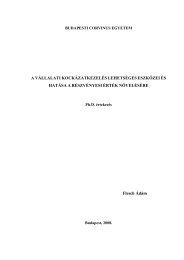Jenei István
Jenei István
Jenei István
Create successful ePaper yourself
Turn your PDF publications into a flip-book with our unique Google optimized e-Paper software.
<strong>István</strong> <strong>Jenei</strong>: Lean transformation of hospital processes – Structuring foreign and Hungarian experiences,<br />
PhD Dissertation, Corvinus University of Budapest, Doctoral School in Business Administration<br />
the system which, in turn, becomes more capable of responding also to this<br />
special challenge (Ghosh and Sobek, 2006).<br />
• At the same time, when the target to be changed is selected, one must<br />
separate the processes characterised by significant variability and the<br />
recurrent activities. Research has demonstrated the existence of many<br />
recurrent processes in health care, to which it is logical to apply the lean<br />
principles (Ghosh and Sobek, 2006).<br />
• Since assignments related to the transformation process may imply<br />
significant extra workload in addition to the daily routine, provisions must<br />
be made to relieve the workers of some of the burdens (Fillingham, 2007).<br />
• Since the targets of the “transformation” in health are typically humans, it<br />
is essential to interpret and communicate the lean principles and tools<br />
adequately. Naturally the personnel will anyway point out that the subjects<br />
of these processes are sensitive human beings and not motorcars.<br />
(Fillingham, 2007; Radnor et al., 2006).<br />
• Quality is interpreted differently in the services area than in industry: in<br />
addition to the outcome, the process itself is evaluated as well<br />
(Parasuraman et al., 1985).<br />
After this review of the special planning requirements due to the service specifics,<br />
let us discuss another typical feature of health care: the division of the person being<br />
served and the one that finances the service.<br />
2.3.2. The difficulties defining the “customer”<br />
The point of departure of the five steps of lean thinking is the definition of<br />
customer value. In Toyota, the user of the product can be defined unambiguously, and<br />
so the company is in a good position to define customer needs.<br />
In health care, on the other hand, it is not quite clear who the “customer” of value<br />
created by the organisation is. For instance, health care must provide also for<br />
- 41 -

















